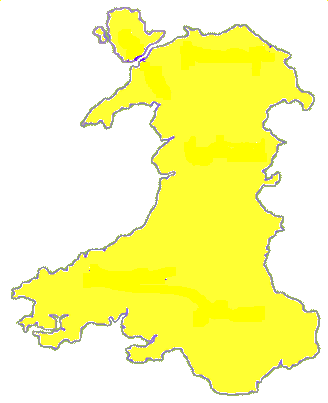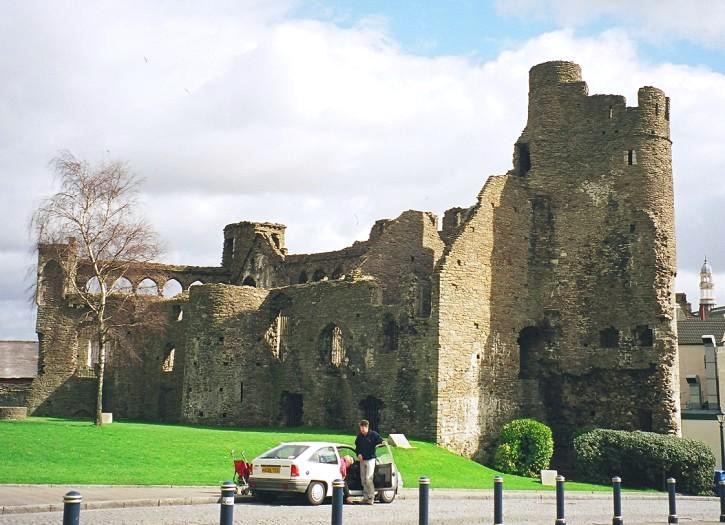THEOSOPHY
WALES


Swansea
Castle
History of
Swansea / Abertawe
Return to Homepage
The Earliest Settlement
Swansea was once Sweins
eg or ey, which means Swein's island. The island stood in the mouth of the River Tawe, hence the Welsh name Abertawe.
Who Swein was is not known for sure but he may have
been a Norseman who built a fort on the island about 1000 AD and used it as a
base for raiding the Welsh coast.
Establishment of the Town
The town of Swansea was founded in the early
12th century when the Normans
conquered the area. The Norman lord built a wooden castle on the site of Worcester Place.
(It was rebuilt in stone in the early 13th century). A town soon grew up by the
castle. The garrison of the castle provided a market for the townspeople's goods.
Many of the townspeople were English immigrants. At some time between 1158-84 Swansea was given a charter ( a document granting the townspeople certain rights). A
second charter was granted by King John in 1215.
The Middle Ages
By the 13th century Swansea was a flourishing town
although it would seem tiny to us with a population of about 1,000. However
towns were very small in those days, especially Welsh towns.
Swansea
was probably fortified with a ditch and an earth rampart with a wooden stockade.
In the early 14th century this was replaced by stone walls. However the
defences did not prevent the Welsh burning the town several times (the last
time was in 1402 during the rebellion of Owain Glendower). Yet whenever this happened Swansea recovered.
In Medieval Swansea the main industries were
leather and wool. In the town wool was woven. It was then fulled,
which means it was cleaned and thickened by being pounded in a mixture of water
and clay. Wooden hammers worked by watermills pounded the wool. It was then
ready for dyeing. There was also a shipbuilding industry in Swansea.
Leather and wool from Swansea were exported to England
so were hides, butter, cheese and grain. In Swansea there was a weekly market.
There were also 2 fairs. In the Middle Ages fairs were
like markets but they were held only once a year. People would come from all
over South Wales
to attend a Swansea
fair.
Swansea
was run by an official called the Portreeve. By the
14th century the Portreeve was assisted by 12
Aldermen. An Alderman was a member of a town council who had been appointed to
the position of councillor for life.
Like all towns Swansea was devastated by the
Black Death of 1348-49 which may have killed half the population.
1500-1750
In this period Swansea grew rapidly. It still
only had a population of about 1,000 in the mid 16th century but it grew to
about 2,000 by the mid 17th century. The port grew busier and busier as coal
mining in South Wales
boomed. Increasing amounts of coal were exported from Swansea. By the 17th century iron
was also exported from Swansea.
Shipbuilding continued. So did the wool
weaving industry. Swansea
was also noted for making gloves. By the 16th century Swansea had 3 fairs rather than
the 2 of the Middle Ages. In 1655 Cromwell said it was
'an ancient port town and populous, situated on the coast towards France, convenient for shipping
and resisting foreign invasions'.
Swansea
castle had been damaged by Owain Glendower
in the 15th century. It was finally demolished by the parliamentarians in 1647
to prevent it ever being used by the Royalists.
In 1682 a grammar school was founded in Swansea.
By the middle of the 18th century Swansea probably had a population
of about 3,000. It was a busy little port and market town. In
1771 Swansea
gained its first bank and in 1785 its first theatre.
The Industrial Revolution
In the late 18th century Swansea began to boom. From 1716
copper was smelted in Swansea.
In 1755 a lead works opened. In 1764 a pottery plant was founded. Pottery
became an important industry during the 19th century. From 1777 zinc was made
in Swansea.
In the 19th century Swansea
became a centre of the metalworking industry. Vast amounts of zinc and copper
were made there then exported through the port. After 1845 tinplate was made in
Swansea.
(Steel covered in tin). By the late 19th century the tinplate industry was
booming.
The port also boomed. It was helped by Swansea canal, which made it
easier to transport heavy raw materials to and from the port. In 1791 a group
of men called the Harbour Commissioners was formed with responsibility for the harbour. North Dock was built in 1852. It was followed by
South Dock in 1859. In 1881 Prince of Wales Dock was built on the east bank of
the Tawe.
There was still a shipbuilding industry in Swansea in the 19th century but it
less important than the metal working trades.
The population of Swansea boomed. In 1801 it was
6,831 but by 1841 it was over 16,000. by the end of
the century it had passed 100,000. Like all 19th century towns Swansea, was overcrowded, dirty
and unsanitary. There were outbreaks of cholera in 1832 and 1849.
Nevertheless there were some improvements in Swansea in the 19th century. In
1808 a dispensary opened where the poor could obtain free medicines. In 1809 an
Act of Parliament formed a body of men called the Paving Commissioners with
responsibility for paving, cleaning and lighting the streets.
In 1821 Assembly Rooms were built where the
well to do could play cards and hold balls. In 1821 Swansea obtained gas street
lighting.
Then in 1835 Swansea local government was
reformed. Swansea
was made a borough with a mayor. Swansea museum was founded in
1835. A general hospital was built in 1864. The first public library in Swansea opened in 1871. Victoria
Park opened in 1887.
The 20th Century
By 1901 Swansea had a population of
134,000. Gynn Vivian Art Gallery opened in 1911. In 1906
the first council houses were built in Swansea. More were built in the
1920s and 1930s as the council demolished slums. Many more were built after
1945 as well as a large number of private houses.
A new Guildhall was built in 1934. Swansea suffered severely in the
bombing raids of the Second World War. In all 387 people were killed in Swansea and the heart of the city
was destroyed. It was rebuilt in the 1960s.
In the early 20th century the port continued
to flourish. Kings Dock was built in 1909. Queens Dock followed in 1920. At the beginning of
the 20th century the tinplate industries was booming. so
were the steel and copper industries. However they suffered severely in the
depression of the 1930s and there was horrifically high unemployment in Swansea.
The local economy boomed again during World
War II but after it ended the traditional metal working industries nosedived.
Coal mining in the Swansea
area disappeared by the end of the 20th century. The council tried to diversify
industry in Swansea
by building new industrial estates including one at Fforestfach
in the late 1940s and another at Cwndu in the 1960s.
Swansea
is still a busy port. The South Dock closed in 1969. It was opened as a marina
in 1982. From the 1920s oil was imported into Swansea. Oil was refined and the
finished product was exported from Swansea. In 1969 a ferry service
to Cork
began.
In 1969 Swansea was made a city. A leisure
centre was built in 1977. Also in 1977 a Maritime and Industrial Museum opened. (It is now closed
and it is planned to replace it with a Waterfront Museum, due to open in 2005). The
Quandrant Shopping Centre opened in 1979. County Hall
was built in 1984.
In the late 1980s a shopping and leisure
centre was built at Parc Tawe
on the site of the North Dock. The centre included a bowling alley and cinema. Plantasia opened in 1990. Parc Tawe Centre was extended in 1997. Also in the 1990s Castle Square
was redeveloped.
Return to Homepage

THEOSOPHY
WALES
For more info on Theosophy
Try these
Dave’s Streetwise Theosophy Boards
The Theosophy Website that
Welcomes Absolute Beginners
Theosophy in Cardiff
Theosophy in Wales
Wales! Wales! Theosophy Wales
The
All Wales Guide to
Getting Started in Theosophy
This
is for everybody not just people in Wales
Cardiff Lodge’s Instant Guide to Theosophy
Cardiff Theosophy Start-Up
A Free Intro to Theosophy
Cardiff Theosophical Archive
Cardiff Blavatsky Archive
Blavatsky Blogger
Independent
Theosophical Blog
Quick Blasts of Theosophy
One Liners & Quick Explanations
Great Theosophists
The Most Basic Theosophy Website
in the Universe
If you run a
Theosophy Group you can use
this as an
introductory handout
Theosophy
The
New Rock ‘n Roll
The Key to Theosophy
The Voice of the Silence
The South of Heaven Guide to
Theosophy and Devachan
The South of Heaven Guide
To Theosophy and Dreams
The South of Heaven Guide
To Theosophy and Angels
Theosophy and Help From
The Universe
Feelgood Theosophy
Visit the Feelgood Lodge
The Tooting Broadway
Underground Theosophy Website
The Spiritual Home of Urban Theosophy
The Mornington Crescent
Underground Theosophy Website
The Earth Base for Evolutionary Theosophy
Try these if you are
looking for a
local
Theosophy
Group or Centre
UK Listing of Theosophical
Groups
Worldwide Directory of
Theosophical Links
International Directory of
Theosophical Societies


